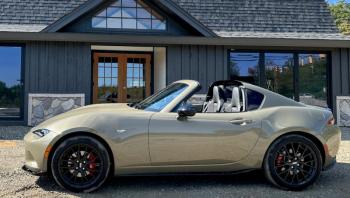Modern throwback: Mazda MX-5 RF Club 6MT
 Mazda’s front-engine, rear-drive MX-5, aka the Miata, is only six feet shorter than a GMC Yukon XL, but it looks like it might fit on the SUV’s roof rack. There’s ample space and comfort for two adult humans, but pack light—the folding hard top fills the trunk. This color is Zircon Sand Metallic.
Mazda’s front-engine, rear-drive MX-5, aka the Miata, is only six feet shorter than a GMC Yukon XL, but it looks like it might fit on the SUV’s roof rack. There’s ample space and comfort for two adult humans, but pack light—the folding hard top fills the trunk. This color is Zircon Sand Metallic.
 All we need and nothing more, including elbow room. Aft of the short-throw 6-speed gear lever is the computer control knob (the screen is hidden by the driver’s sun visor), the radio knob and a small storage compartment. In lieu of a glove box, there’s another small compartment between the seatbacks. The shiny rear slab of roof provides roll-over protection. The seats adjust manually but are heated. Note the electric window switches and mirror controls (unheard of in vintage roadsters) and, for those movie-stunt turns, the handbrake lever. Yes, an automatic transmission is available. If you insist.
All we need and nothing more, including elbow room. Aft of the short-throw 6-speed gear lever is the computer control knob (the screen is hidden by the driver’s sun visor), the radio knob and a small storage compartment. In lieu of a glove box, there’s another small compartment between the seatbacks. The shiny rear slab of roof provides roll-over protection. The seats adjust manually but are heated. Note the electric window switches and mirror controls (unheard of in vintage roadsters) and, for those movie-stunt turns, the handbrake lever. Yes, an automatic transmission is available. If you insist.
 Mazda’s front-engine, rear-drive MX-5, aka the Miata, is only six feet shorter than a GMC Yukon XL, but it looks like it might fit on the SUV’s roof rack. There’s ample space and comfort for two adult humans, but pack light—the folding hard top fills the trunk. This color is Zircon Sand Metallic.
Mazda’s front-engine, rear-drive MX-5, aka the Miata, is only six feet shorter than a GMC Yukon XL, but it looks like it might fit on the SUV’s roof rack. There’s ample space and comfort for two adult humans, but pack light—the folding hard top fills the trunk. This color is Zircon Sand Metallic.
 All we need and nothing more, including elbow room. Aft of the short-throw 6-speed gear lever is the computer control knob (the screen is hidden by the driver’s sun visor), the radio knob and a small storage compartment. In lieu of a glove box, there’s another small compartment between the seatbacks. The shiny rear slab of roof provides roll-over protection. The seats adjust manually but are heated. Note the electric window switches and mirror controls (unheard of in vintage roadsters) and, for those movie-stunt turns, the handbrake lever. Yes, an automatic transmission is available. If you insist.
All we need and nothing more, including elbow room. Aft of the short-throw 6-speed gear lever is the computer control knob (the screen is hidden by the driver’s sun visor), the radio knob and a small storage compartment. In lieu of a glove box, there’s another small compartment between the seatbacks. The shiny rear slab of roof provides roll-over protection. The seats adjust manually but are heated. Note the electric window switches and mirror controls (unheard of in vintage roadsters) and, for those movie-stunt turns, the handbrake lever. Yes, an automatic transmission is available. If you insist.
As a member of the Mid Maine Sports Car Club, I get to hang with interesting automobiles, including no end of vintage roadsters from Jolly Old England. If you’ve forgotten, or are too young to know, let me remind you that those things (c. 1950-75) are tiny. Today’s average overfed American would be hard-pressed, literally, to squeeze into a 1968 MGB Roadster, and that’s with the top down; a hardtop MGB GT? Get the shoehorn and the Vaseline.
With this MX-5 Miata looking like a pedal car in my driveway, I dug up the specs of an original MGB to compare the two. At 158 inches, the Brit roadster was actually four inches longer than the Miata; also an inch taller! The wheelbase, the distance between the axles, is the same to within a tenth of an inch (which can’t be coincidence), but the modern car is fully eight inches wider, which makes it far less claustrophobic. OK, so we understand what Mazda is recreating here, don’t we? And improving upon?
MGBs, as I recall from college days, were great fun to drive—rorty, snorty and quick. Ah, the rose-tinted lenses of nostalgia . . . it turns out that today’s Miata not only weighs some 200 pounds less than a ‘68 MGB, which is astonishing in light of the safety equipment on modern cars, but it’s also nearly twice as powerful: 181 horses and 151 pound-feet of torque vs. 95 and 110. So today’s MX-5 is rortier, snortier and much quicker—and faster—than ye Olde Crock. But not insanely so; it can be enjoyed without risking death, dismemberment, fines and jail time.
A Miata is also light-years safer than an MGB, 100 percent leakproof (the top, windows, door seals and floor pan don’t admit rain and the 2.0-litre Four doesn’t weep oil) and comes with features unheard of in 1960: an Internet-linked multifunction computer, Alexa, Bluetooth, satellite radio, USB ports, a backup camera, LED lights, cruise control, airbags, stability control, anti-lock brakes, emergency braking assistance, blind-spot alerts, intermittent wipers, seat heaters, steering-wheel controls and power-assisted everything—all mod cons, as the British used to say.
The first power-operated convertible hard top appeared in 1935 (Peugeot), but I’d bet it didn’t operate as smoothly, quietly and quickly as this one does. And finally, for my fellow car-club members: Nothing in the electrical system comes from Lucas, the Prince of Darkness, so everything functions reliably. For the same reason, the Miata is also extremely unlikely to set itself afire while underway. (One of my friends dealt with smoke issuing from the glovebox of his TR3 by reaching in and yanking out a handful of wires.)
To great applause, Mazda rolled out the first Miata in 1989. Our ’24 model is only the fourth generation of the car in 35 years, which speaks to how little updating is required to fulfill its mission (elemental driving fun). By now, more than a million have been sold, making it one of the most popular sports cars ever.
Last evening I motored across town to pick up a pizza—the top was down, the air balmy, the sunset shimmering. Turning left off Gould Street onto Washington, I caught the revs just right with the clutch and rode the torque curve—second gear, third gear—past the car wash and up the hill, then backed off at the crest to let the engine braking bring me down past the fire station to the right-hander at Mechanic Street, then wiggled past the tourists, through Malfunction Junction over to Limerock Street and on home.
No speed limits or pedestrians were endangered and no risks were run. It was merely a brief but lovely and spur-of-the-moment exercise in responsiveness, balance and hand-eye coordination. In an era when some two-seaters cost hundreds of thousands and seem to have nuclear reactors between their axles, a $40,000, 181-horsepower Miata is a miraculous and wonderful thing. Arigato, Bob Hall, Kenichi Yamamoto, Gai Arai and everyone else at Mazda.
Next week: Honda Pilot Black Edition
























